Javiera Guíñez1, Diego Lazo-Pérez2, Gonzalo Rojas-Alcayaga1,3, Iván Gallegos3, Claudio Bustamante-Gambotto2, Andrea Maturana-Ramírez1,2*
1Departament of Oral Pathology and Medicine, Faculty of Dentistry, University of Chile, Santiago, Chile
2Hospital Complejo San José Santiago, Chile
3Department of Pathological Anatomy, Faculty of Medicine. University of Chile, Chile
*Correspondence author: Andrea Maturana-Ramirez, Department of Oral Pathology and Medicine, Faculty of Dentistry, University of Chile, Santiago, Chile and Hospital Complejo San José Santiago, Chile;
Email: [email protected]
Published Date: 24-09-2024
Copyright© 2024 by Guíñez J, et al. All rights reserved. This is an open access article distributed under the terms of the Creative Commons Attribution License, which permits unrestricted use, distribution, and reproduction in any medium, provided the original author and source are credited.
Abstract
Epithelioid Hemangioma (EH) is a rare benign vascular tumor characterized by well-formed blood vessels and epithelioid endothelial cells. Known as Angiolymphoid Hyperplasia with Eosinophilia (ALHE), the World Health Organization does not recommend the use of this term since 2020. Despite its common occurrence in subcutaneous soft tissues of head and neck, cases involving oral mucosa and other extra cutaneous areas are infrequent. This article presents a case of EH in an unusual location and discusses the differential diagnosis with other entities, including Kimura´s Disease (KD). We report the clinical case of a 26 year old man with no significant medical history who presented with a painless increase in volume on the right upper lip, subsequently diagnosed as EH through biopsy and histopathology. The lesion exhibited typical clinical features and a complex histological pattern including epithelioid endothelial cells and an inflammatory infiltrate rich in eosinophils. Diagnosis of EH is challenging due to morphological variability and the need to differentiate it from similar conditions such as KD. Differential diagnosis is crucial, especially in atypical locations. This case shows the importance of histopathology and complementary examinations in diagnosis and the need to consider KD in the differential diagnosis due to its therapeutic and prognostic implications. Therefore, it is concluded that EH, although benign, requires a rigorous diagnostic approach to differentiate it from similar diseases and manage it appropriately. Continuous control is essential due to the potential for recurrence. This case shows the importance of careful differential diagnosis, especially in atypical locations, to optimize management and improve patient outcomes.
Keywords: Kimura´s Disease; Epithelioid Hemangioma; Angiolymphoid Hyperplasia with Eosinophilia
Introduction
Epithelioid Hemangioma (EH) is a rare benign vascular neoplasm characterized by well-formed blood vessels and epithelioid endothelial cells, accompanied by an inflammatory infiltrate with variable concentrations of eosinophils [1]. Even though it is traditionally known as Angiolymphoid Hyperplasia with Eosinophilia (ALHE), the World Health Organization (WHO), in its classification of soft tissue and bone tumors of 2020, does not recommend the use of the term ALHE to refer to EH [1,2].
Approximately 85% of these lesions are in subcutaneous soft tissues of the head and neck, specifically in the frontal region, preauricular area and scalp [3,4]. However, cases in extra-cutaneous areas such as oral mucosa, parotid gland and orbit have been reported [5]. It was considered a Western variant of Kimura’s Disease (KD), due to its similarity in histological appearance and clinical characteristics, but today it is recognized as a distinct pathological process [6-8].
Vascular damage or trauma have been suggested as the etiological factors in cutaneous lesions, while molecular alterations, including FOS and FOSB gene fusions, have been detected in soft tissue tumors [1,9].
In this article, we present a case of EH in an uncommon location, discuss the evolution after treatment with excisional surgery and review crucial aspects of the differential diagnosis with other vascular entities.
Case Summary
The present case has been authorized through informed consent of the patient and approved by the ethics committee of San José Hospital in Santiago de Chile, in accordance with the Helsinki Declaration of 1975.
A 26-year old man, with no relevant medical history, consulted in December 2023 at the Oral and Maxillofacial Pathology Department of San José Hospital. The patient reported an increase in volume on the right side of the upper lip, with an approximate evolution of one and a half years, without apparent cause according to his report. Clinical approach showed a single, slightly erythematous and spherical nodule beneath the lip mucosa, of firm consistency and approximately 10 mm in diameter, with a smooth surface and telangiectasia on the mucosa surface. This nodule displaced within its anatomical plane upon digital pressure, was painless and grew slowly (Fig. 1,2). With a diagnostic hypothesis of neurilemmoma, the patient was referred to maxillofacial surgery for excisional biopsy, which was performed routinely in January 2024. The specimen was sent for histopathological study and postoperative patient follow-up indicated favorable evolution. Histopathologically, after a detailed macroscopic examination (Fig. 3), it showed a well-defined proliferation of blood vessels lined by protruding endotheliocytes, large in size and epithelioid in appearance, organized in lobules on an active lymphocytic background, with the notable presence of eosinophils and lymphoid follicles, some of them with germinal center (Fig. 4-6). Immunohistochemical techniques including CD34, CD3, CD5, CD20 and Ki-67 were applied for lineage determination and cell proliferation index (Fig. 7-11). The histopathological diagnosis was Epithelioid Hemangioma. Finally, to rule out other related conditions such as Kimura’s disease, laboratory tests including eosinophil count and plasma IgE levels were requested. The results for these tests were 317 x mm2 and 30 IU/mL respectively, which is within normal parameters. In the last control in July, the patient did not have recurrences, so it has not been necessary to plan new treatments except for rigorous controls. Favorable long-term results are expected, given how well demarcated the lesion was.
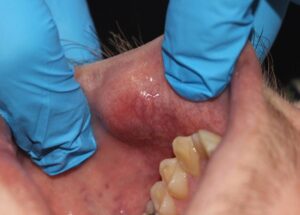
Figure 1: Clinical photograph. Submucosal nodule on the right side of the upper labial mucosa.
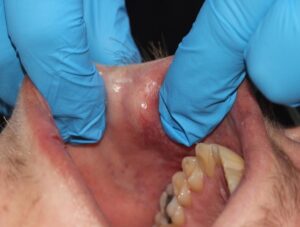
Figure 2: Clinical photographs. The nodule rolls across the anatomical plane at clinical pressure.
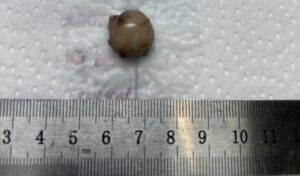
Figure 3: Macroscopic photograph. Oval sample with a smooth, firm surface measuring 16 x 14 x 10 mm.
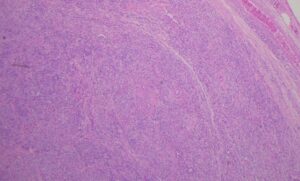
Figure 4: Hematoxylin-eosin staining micrograph. Magnification 4X. Cell proliferation is arranged in lobes and highlights the numerous amount of blood vessels on an inflammatory infiltrate.
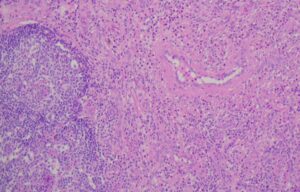
Figure 5: Hematoxylin-eosin staining micrograph. Magnification 10X. There are numerous blood vessels lined by large, protruding endotheliocytes with an epithelioid appearance, on an active lymphocytic background containing lymphoid follicles.
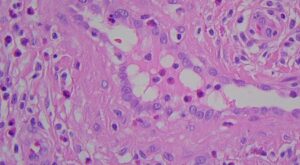
Figure 6: Hematoxylin-eosin staining micrograph. Magnification 40X. Epithelioid endotheliocytes delimiting a capillary and surrounded by a lymphocytic infiltrate rich in eosinophils. The interior of the blood vessel also presents a significant number of eosinophils.
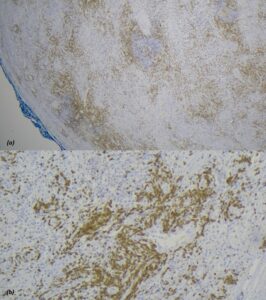
Figure 7: Immunohistochemical micrographs for CD3. (a) 2.5X and (b) 10X magnification. Positive staining in the membrane and cytoplasm of lymphoid cells in the stroma, (a) lymphocytes dispersed in the stroma of the neoplasm and surrounding lymphoid follicles (b) the lymphocytes also surround blood vessels in a disorganized manner.
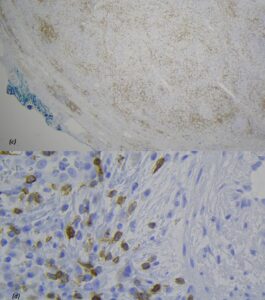
Figure 8: Immunohistochemical micrographs for CD5. (c) 2.5X magnification and (d) 40X. Positive staining in the membrane and cytoplasm of stromal lymphoid cells, (c) which are dispersed in the tissue studied, visible at magnification with a magnifying glass and (d) higher magnification.
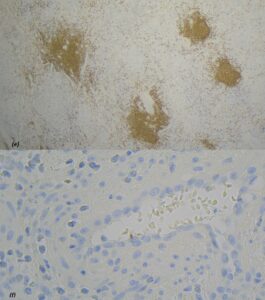
Figure 9: Immunohistochemical micrograph for CD20. (e) 2.5X magnification and (f) 40X. Positive staining in the membrane of stromal lymphoid cells, (e) which are focused in germinal centers of lymphoid follicles and dispersed in the stroma, (f) CD20+ cells are scarce perivascular.
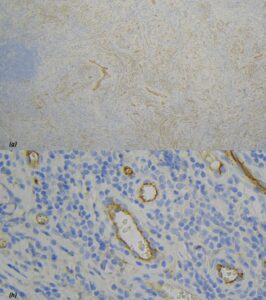
Figure 10: Immunohistochemical micrographs for CD34. (g) 2.5X magnification and (h) 4X. Positive membrane staining in endothelial cells. (g) Florid proliferation of blood vessels is observed in the neoplasm. (h) At higher magnification, it is evident that the endothelial cells lack a flat appearance and acquire an epithelioid shape.
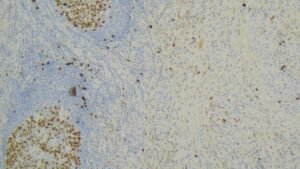
Figure 11: Immunohistochemical micrograph for Ki67 (MIB1) Magnification 10X. The proliferation index of neoplastic cells is approximately 5% and germinal center activity is evident to the left of the micrograph in lymphoid follicles.
Case Discussion
The EH was first described in 1969 by Wells and Whimster and called ALHE [7]. However, since the 1980s the name ALHE began to be replaced by EH when Enzinger and Weiss proposed it due to the possible neoplastic behavior [10]. Since 2020, when its neoplastic nature was confirmed, the WHO has not recommended the appellation ALHE [1]. This change is reflected in the effort to use terms that precisely describe the neoplastic characteristics instead of the inflammatory ones, which is crucial for a correct diagnosis and clinical management. However, to date, several authors continue to use this terminology interchangeably.
ALHE was considered a vascular proliferative disorder of uncertain etiopathogenesis associated with an inflammatory or neoplastic process and its pathogenesis is currently considered to be neoplastic, due to a rearrangement in FOS or FOSB that drives tumorigenesis [1,11].
Clinically, the lesions of EH present as quite small angioma-like nodules, reddish to brown or violaceous erythematous which may have a smooth or slightly lobulated surface. The most frequently affected sites are subcutaneous of the preauricular area and scalp, often in the distribution of superficial temporal artery [12-15]. Extracutaneous lesions occurring in muscular, bone and salivary glands were infrequently reported. Lesions involving oral mucosa are rarely noted [12].
In the oral cavity, EH is typically present as reddish to brown erythematous nodules which may have a smooth or slightly lobulated surface [12]. The nodules are often well-circumscribed and the overlying mucosa can appear thin, stretched, or tense due to the vascular nature of the lesion. In some cases, the lesions may have a translucent or bluish tint, depending on the depth of the vascular proliferation [14]. Ulcers, macules and pruritus were other presenting signs and symptoms [13]. Sun ZJ, et al., reported seven cases in oral mucosa, they described that the most common presentation was a painless solitary mass. They described EH in the oral mucosa as rarely reported, therefore, a proper statistical analysis is not feasible, but they find oral EH seems to have a predilection of men and most prominently in young adults. The lips are the most frequent site, followed by the tongue, buccal mucosa and palate [12].
In the present study, we observed a painless, slow growth unique nodule with an erythematous mucosal surface, similar to those reported in the literature. The nodule had a smooth surface and was well-defined, with no evidence of ulceration or bleeding, features commonly associated with trauma or secondary inflammation.
There was no presentation of multifocality during the last follow-up, which aligns with some reports where lesions remain isolated [12].
In the labial mucosa, where the tumor was located, the most prevalent pathologies tend to be benign neoplasms of salivary glands and soft tissues such as neurilemmoma and neurofibroma, among others [16,17]. Therefore, the diagnostic hypothesis was a neurilemmoma, because of the firm consistency, location, color, not initially thinking in a vascular tumor.
Diagnosis of EH is challenging due to its wide spectrum of morphologic presentations. Definitive diagnosis requires a histopathologic exam, although imaging can help distinguish EH from other vascular or soft tissue lesions [5]. For this case, imaging tests were not indicated since clinically, it was not considered to be a vascular anomaly.
Histopathologically, EH shows well-formed vascular channels lined by epithelioid appearing endothelial cells and a wide spectrum of morphologic appearance, including a cellular/solid pattern, intense inflammatory infiltrate and occasional intravascular growth [16]. The diverse histologic spectrum is also seen in the variety of previous designations, including ALHE and histiocytoid hemangioma [18]. Epithelioid endothelial cells have abundant densely eosinophilic cytoplasms and line capillary-sized vascular lumens. Although these features are distinctive, the differential diagnosis should consider other epithelioid vascular tumors, including epithelioid hemangioendothelioma, epithelioid angiosarcoma and Kaposi sarcoma [4,19].
For epithelioid hemangioendothelioma, it is important to observe infiltration in strands, cords and nests of epithelioid cells, but also fusiform and histiocytoid cells. Also, the cells should be positive for CD31, ERG and CAMTA1 or TFE3 [20]. In this case, due to the clear delimitation and lobulated architecture, it was ruled out as a possible diagnosis.
Epithelioid angiosarcoma is histopathologically characterized as an infiltrating, angioproliferative neoplasm. However, the endothelial cells present nuclear atypia and the architecture of the vessels, which may present a multilayered endothelium, can frequently show necrosis, hemorrhage and secondary ulceration. This was not observed here, but suspected cases will require immunohistochemistry in which the neoplastic cells express CD31 and ERG [21,22]. In this case, the unusual location adds complexity to the diagnosis and must be considered when facing single, well-defined nodules with a superficial vascular appearance in the oral cavity [4]. Although this pathology is rare, a similar case diagnosed as ALHE was reported by the Hospital Santiago Oriente in collaboration with the University of Chile and was published in 2007 [23].
According to the WHO, the essential criteria for diagnosis are lobular architecture with neoformation, endothelial cells with an epithelioid appearance and eosinophilic cytoplasm and loose stroma with eosinophils [1]. All these characteristics were clearly identifiable in this case.
The KD is the main differential diagnosis of EH, due to the clinical and histopathological similarity and is differentiated by laboratory tests. KD consists of a rare chronic inflammatory disorder observed mainly in young men and adults between the second and fourth decades of life [19,20,24]. It usually presents in patients of Asian origin as deep nodules or subcutaneous lesions that involve the head and neck region, major salivary glands and also regional lymph nodes involvement [20,23].
The histopathological exam is characterized by hyperplasia of lymphoid tissue, well-developed lymphoid follicles, marked infiltration of eosinophils, proliferation of thin-walled capillary venules and varying degrees of fibrosis [21,25]. However, KD is accompanied by a significant increase in plasma levels of IgE and eosinophilia [4,26,27]. In this case carrying out a careful differential diagnosis is relevant, given the high level of recurrence associated with KD, which could reach up to 62% of treated cases [5]. The relation between KD and EH has always been debated. At the beginning of the seventies, these diseases were considered as different stages of a spectrum [7]. Nevertheless, with greater understanding, differences in origin have been found between them. From the end of the eighties, both diseases have been accepted as distinct pathological entities [8]. The pathogenesis of EH has been controversial for a long time. Chromosomal translocation that harbors FOS or FOSB rearrangements drives tumorigenesis in a significant portion of tumors [28]. Some initial reports suggest that skeletal EH represents a variant of epithelioid hemangioendothelioma, because it has metastatic potential [29,30]. It is currently widely recognized that HE is a benign neoplasia and may tend to have a locoregional growth [1].
In terms of treatment, the surgical excision is the main focus, although diffuse or recurrent lesions may require additional therapies such as laser, cryotherapy or corticosteroids [5,26]. The average reported recurrence is 33%, lower than KD reports and is mainly attributed to a lack of complete surgical removal, because of a possible local or regional growth, or surgical difficulties on anatomical sites with complex access [5,6]. Non-confluent lesions of clear margins will respond better to surgical treatment [4]. Therefore, the surgical excision seems to be the most effective treatment for EH, even if it may recur [5].
Oral propanol, high doses of corticosteroids and cryotherapy have been proposed as therapeutic adjuvants [31]. Cytotoxic drugs such as cyclophosphamide and methotrexate are useful for treating diffuse lesions or when corticosteroids are administered. Emerging alternatives, such as interleukin-5-based therapy, are promising as they focus on underlying pathogenic mechanisms, interfering with eosinophil differentiation and activation [31]. The patient has had regular checks and the lesion has behaved as described in the literature, so new approaches have not been necessary.
Conclusion
EH is a rare benign vascular neoplasm that poses significant diagnostic challenges due to its similarity to other pathologies. Accurate diagnosis is crucial for effective management, which requires meticulous clinical and histopathological evaluation. It is imperative to differentiate it from KD, as the latter has a characteristic immunological profile and a different prognosis. Even though EH is a benign neoplasm. Follow-up should always be monitored to avoid potential recurrences.
Conflict of Interests
The authors declare they do not have conflicts of interest.
References
- WHO Classification of Tumours Editorial Board. Head and neck tumours. Lyon (France): International Agency for Research on Cancer; 2023. [Last accessed on: September 17, 2024]
https://tumourclassification.iarc.who.int/chapters/52
- Atiq A, Raza M, Ud Din N. Hiperplasia angiolinfoide con eosinofilia. Sitio web PathologyOutlines.com. [Last accessed on: September 17, 2024]
https://www.pathologyoutlines.com/topic/lymphnodesangiolymphoidhyperplasiawitheosinophili.html.
- Rahman A, Asad Shabbir SM, Tabassum S, Hafeez J. Auricular angiolymphoid hyperplasia with eosinophilia. J Coll Physicians Surg Pak. 2011;21(10):623-5.
- Guinovart RM, Bassas-Vila J, Morell L, Ferrándiz C. Angiolymphoid hyperplasia with eosinophilia: a clinicopathologic study of 9 cases. Actas Dermosifiliogr. 2014;105(2):e1-6.
- Adler BL, Krausz AE, Minuti A, Silverberg JI, Lev-Tov H. Epidemiology and treatment of angiolymphoid hyperplasia with eosinophilia (ALHE): A systematic review. J Am Acad Dermatol. 2016;74(3):506-12.e11.
- Sanchez-Orgaz M, Insausti-Garcia A, Ye`benes Gregorio L. Epithelioid hemangioma of the orbit or angiolymphoid hyperplasia with eosinophilia. Ophtal Plast Reconst Surg. 2014;30:e70-2.
- Wells GC, Whimster IW. Hiperplasia angiolinfoide subcutánea con eosinofilia. Br J Dermatol. 1969;81:1-14.
- Googe PB, Harris NL, Mihm MC Jr. Kimura’s disease and angiolymphoid hyperplasia with eosinophilia: two distinct histopathological entities. J Cutan Pathol. 1987;14(5):263-71.
- Huang SC, Zhang L, Sung YS, Chen CL, Krausz T, Dickson BC, et al. Frequent FOS Gene Rearrangements in Epithelioid Hemangioma: A Molecular Study of 58 Cases With Morphologic Reappraisal. Am J Surg Pathol. 2015;39(10):1313-21.
- Guo R, Carlo A. Angiolymphoid Hyperplasia With Eosinophilia. Arch Pathol Lab Med. 2015;139(5):683-6.
- Wells GC, Whimster IW. Subcutaneous angiolymphoid hyperplasia with eosinophilia. Br J Dermatol. 1969;8(1):1-14.
- Sun ZJ, Zhang L, Zhang WF, Alsharif MJ, Chen XM, Zhao YF. Epithelioid hemangioma in the oral mucosa: a clinicopathological study of seven cases and review of the literature. Oral Oncol. 2006;42(5):441-7.
- Ansari M, Ansari M, Fazli JT, Safar F, Alizadeh N, Heidari N, et al. Epithelioid hemangioma (ALHE) on the tongue of an infant treated with oral corticosteroids: A case report and review of the literature. J Family Med Prim Care. 2023;12(6):1069-71.
- Brahmbhatt AN, Skalski KA, Bhatt AA. Vascular lesions of the head and neck: an update on classification and imaging review. Insights Imaging. 2020;11(1):19.
- Sedran L, Bonaso M, Mettus A, Roccia F. Epithelioid hemangioma of the face. J Craniofac Surg. 2018;29(8):e736-9.
- Rosenberg AE. Epithelioid hemangioma: A rare vascular entity. J Oral and Maxillofacial Pathol. 2002;14(1):45-52.
- Neville B, Damm D, Allen C, Bouquot J. Salivary gland pathology and soft tissue tumors. en: oral and maxillofacial pathology. Segunda Edición. Philadelphia. USA. 2002;406-78.
- Rosai J, Gold J, Landy R. The histiocytoid hemangiomas: A unifying concept embracing several previously described entities of the skin, soft tissue, large vessel, bone and heart. Hum Pathol. 1979;10:707-30.
- Torrence D, Antonescu CR. The genetics of vascular tumours: an update. Histopathology. 2022;80(1):19-32.
- George R. Vascular tumors of the oral cavity: A clinical and histopathological review. Oral and Maxillofacial Pathology J. 2015;22(3):95-101.
- Nelson BL, Thompson LD. Sinonasal tract angiosarcoma: a clinicopathologic and immunophenotypic study of 10 cases with a review of the literature. Head Neck Pathol. 2007;1(1):1-12.
- Fanburg-Smith JC, Furlong MA, Childers EL. Oral and salivary gland angiosarcoma: a clinicopathologic study of 29 cases. Mod Pathol. 2003;16(3):263-71.
- Salinas O, Corredoira Y, Rojas G. Hiperplasia angiolinfoidea con eosinofilia: Presentación de un caso en cavidad oral y revisión de la literatura. Rev Méd Chile. 2007;135:636-9.
- Fetsch JF, Weiss SW. Observations concerning the pathogenesis of epithelioid hemangioma (angiolymphoid hyperplasia). Mod Pathol. 1991;4(4):449-55.
- Flucke U, Karanian M, Broek RWT, Thway K. Soft tissue special issue: perivascular and vascular tumors of the head and neck. Head Neck Pathol. 2020;14(1):21-32.
- Zhou P, Zhang W, Shi W, Zhang Y. Kimura disease. Dermatol Online J. 2017;23(10):13030.
- Sangwan A, Goyal A, Bhalla AS, Kumar A, Sharma R, Arava S, et al. Kimura disease: A case series and systematic review of clinico-radiological features. Curr Probl Diagn Radiol. 2022;51(1):130-42.
- Sherpa M, Lamichaney R, Roy AD. Kimura’s disease: A diagnostic challenge experienced with cytology of postauricular swelling with histopathological relevance. J Cytol. 2016;33(4):232-5.
- Antonescu CR, Chen HW, Zhang L, Sung YS, Panicek D, Agaram NP, et al. ZFP36-FOSB fusion defines a subset of epithelioid hemangioma with atypical features. Genes Chromosomes Cancer. 2014;53(11):951-9.
- Evans HL, Raymond AK, Ayala AG. Vascular tumors of bone: A study of 17 cases other than ordinary hemangioma, with an evaluation of the relationship of hemangioendothelioma of bone to epithelioid hemangioma, epithelioid hemangioendothelioma and high-grade angiosarcoma. Hum Pathol. 2003;34(7):680-9.
- McClintic EA, Andrew Ting, Patrick Yeatts R. Oral propranolol as an alternative therapy for orbital angiolymphoid hyperplasia with eosinophilia. Ophthal Plast Reconstr Surg. 2016;32:e139-40.
Article Type
Case Report
Publication History
Received Date: 25-08-2024
Accepted Date: 17-09-2024
Published Date: 24-09-2024
Copyright© 2024 by Guíñez J, et al. All rights reserved. This is an open access article distributed under the terms of the Creative Commons Attribution License, which permits unrestricted use, distribution, and reproduction in any medium, provided the original author and source are credited.
Citation: Guíñez J, et al. Characterization and Management of Epithelioid Hemangioma on the Lip Mucosa: A Case Report. J Dermatol Res. 2024;5(3):1-12.

Figure 1: Clinical photograph. Submucosal nodule on the right side of the upper labial mucosa.

Figure 2: Clinical photographs. The nodule rolls across the anatomical plane at clinical pressure.

Figure 3: Macroscopic photograph. Oval sample with a smooth, firm surface measuring 16 x 14 x 10 mm.

Figure 4: Hematoxylin-eosin staining micrograph. Magnification 4X. Cell proliferation is arranged in lobes and highlights the numerous amount of blood vessels on an inflammatory infiltrate.

Figure 5: Hematoxylin-eosin staining micrograph. Magnification 10X. There are numerous blood vessels lined by large, protruding endotheliocytes with an epithelioid appearance, on an active lymphocytic background containing lymphoid follicles.

Figure 6: Hematoxylin-eosin staining micrograph. Magnification 40X. Epithelioid endotheliocytes delimiting a capillary and surrounded by a lymphocytic infiltrate rich in eosinophils. The interior of the blood vessel also presents a significant number of eosinophils.

Figure 7: Immunohistochemical micrographs for CD3. (a) 2.5X and (b) 10X magnification. Positive staining in the membrane and cytoplasm of lymphoid cells in the stroma, (a) lymphocytes dispersed in the stroma of the neoplasm and surrounding lymphoid follicles (b) the lymphocytes also surround blood vessels in a disorganized manner.

Figure 8: Immunohistochemical micrographs for CD5. (c) 2.5X magnification and (d) 40X. Positive staining in the membrane and cytoplasm of stromal lymphoid cells, (c) which are dispersed in the tissue studied, visible at magnification with a magnifying glass and (d) higher magnification.

Figure 9: Immunohistochemical micrograph for CD20. (e) 2.5X magnification and (f) 40X. Positive staining in the membrane of stromal lymphoid cells, (e) which are focused in germinal centers of lymphoid follicles and dispersed in the stroma, (f) CD20+ cells are scarce perivascular.

Figure 10: Immunohistochemical micrographs for CD34. (g) 2.5X magnification and (h) 4X. Positive membrane staining in endothelial cells. (g) Florid proliferation of blood vessels is observed in the neoplasm. (h) At higher magnification, it is evident that the endothelial cells lack a flat appearance and acquire an epithelioid shape.

Figure 11: Immunohistochemical micrograph for Ki67 (MIB1) Magnification 10X. The proliferation index of neoplastic cells is approximately 5% and germinal center activity is evident to the left of the micrograph in lymphoid follicles.


